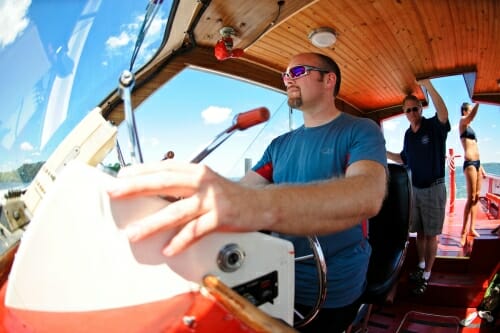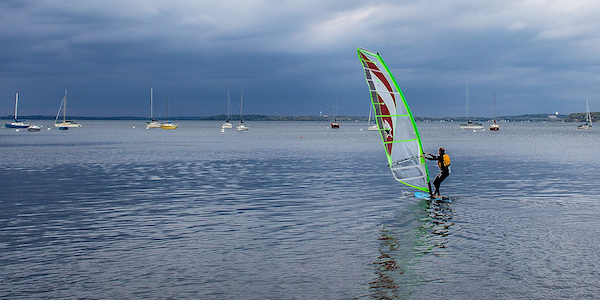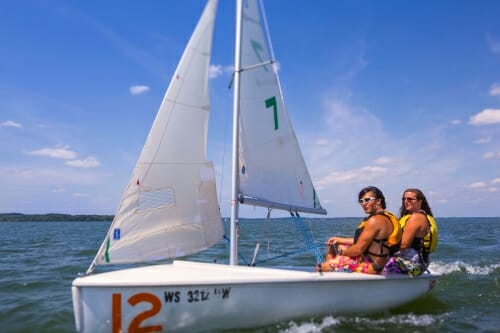Memorial Union steam whistle sets rhythm of summer evenings — and saves lives
It can be heard for miles. It heralds another Terrace sunset. Sometimes, it even gets applause for another fine performance.
And, oh yeah, it saves lives.
It’s the steam whistle atop the Lake Safety Tower on Helen C. White Hall next to the Memorial Union.
Since the whistle can be heard for miles around the city, its announcement of dusk helps define the rhythm of summer evenings in Madison. VIDEO BY NATE MOLL
With a foghorn boom, the whistle peals out each evening one hour before sunset, a signal to all boats on Lake Mendota to head for shore before dark. Those on the Terrace at the appointed time can catch the minute-long run-up as the whistle prepares to call out the end to another day.
And since the whistle can be heard for miles around the city, its announcement of dusk helps define the rhythm of summer evenings in Madison, where sunset can come as late as 8:41 p.m.
But while sunset is rarely a surprise, summer storms often are. That’s when the steam whistle shines.
Eyes on the lake — and the skies
On the southern shore of Lake Mendota, just west of James Madison Park, a concrete tower juts out to peer across the lake. This is the UW Lifesaving Station.
For 110 years, UWPD Lake Rescue and Safety has kept eyes on the lake, tracked lake conditions, and participated in lifesaving missions. Here, a handful of permanent staff and a small army of seasonal employees work to keep university sailors and swimmers safe, while also providing lifesaving services to the public.

Sean Geib (at wheel) and crew members keep a watchful eye as they make their morning patrol in a rescue boat on Lake Mendota in June 2012. Photo: Bryce Richter
It’s a job akin in many ways to that of firefighters, with extensive downtime punctuated by frenzied activity. But the station engenders fierce loyalty; many staff come back each year for decades.
From their vantage point, Lake Rescue can survey 80 percent of Lake Mendota. At least one guard constantly watches the lake from the small, glass-enclosed observation room at the top of the tower. There, they scan for any sign of distress using binoculars and spotting scopes.
The station also monitors lake conditions and communicates them to would-be boaters and swimmers. The outpost has a weather station, and staff make daily trips to the middle of the lake to record the conditions in open water. Virtual flags are flown on the station’s website and at the Hoofers marina: green for fair conditions; blue for heavier winds; yellow when conditions warrant staying closer to shore.
When a storm approaches, the red flag flies.
From their station, Lake Rescue staff can see the prevailing winds push dark storm clouds in from the west. They also track storms using weather radar from the station’s computer. Closing the lake is as much art as science.

A windsurfer gets ready to head back to shore as a storm approaches in October 2017. Photo: Hyunsoo Léo Kim
“It all depends on the number of boats that are out, how far away they are, what the winds are doing, what they’re forecasted to do, and how quickly the storms are moving in,” says Sean Geib, supervisor at Lake Rescue. “We will often go red before the National Weather Service issues a severe thunderstorm warning.”
When they’re ready to close the lake, staff put up the red flag and light up flashing red lights at their tower, the boat launch at Lot 60, the Hoofers marina and Picnic Point. Then they reach over and activate the steam whistle through a connection back to campus.
The whistle rings out three times in short succession to signal the approaching storm.
“People first, equipment second.”
Outdoor UW, which includes the Hoofer Sailing Club, serves as the gateway to the lake for some 10,000 people each season through rentals, youth groups, paddleboard yoga and sailing instruction and boating.
Each of those visitors gets drilled in a culture of safety.

Two students take advantage of the nice weather by sailing on Lake Mendota in 2014. Courtesy of Wisconsin Union
The sailing club closely coordinates with UWPD Lake Rescue and Safety. The two communicate about lake conditions for the day from their different vantage points. And Hoofers has its own fleet of rescue boats to complement the two operated by Lake Rescue.
“When red flag conditions happen, first and foremost, we get everybody to shore,” says sailing program manager Dave Elsmo. “After everybody’s in, all the boats get pulled out of the water, everything gets locked, all the boats get secured. The lifts that they pull out on get locked. Everyone checks their equipment back in. And all of this happens within the span of 15 to 20 minutes most days.”
“It’s a people first, equipment second mentality,” says Elsmo.
Hoofers’ club model promotes accountability and safety. Instead of anonymous day rentals, boaters maintain equipment for one another. And lessons proceed through a series of condition- and boat-specific tests so sailors are prepared for weather.
For years, red flag procedures experienced a tight bottleneck. Just three slipways were available for removing the most popular, smallest boats in the Hoofers fleet, leading to long lines to clear the water. The new Tong Family Marina, which is nearing completion, features a large T-shaped floating dock with 48 slipways.
“Every single boat in our fleet can pull out of the water in the exact same second,” says Elsmo. “We’ve effectively taken a 45-minute process and turned it into a 5-minute process.”
While sunset is rarely a surprise, summer storms often are. That’s when the steam whistle shines.
And if anyone deliberately flouts the rules by staying out during a storm? Their sailing privileges could be stripped away. Only university boaters are subject to oversight by Hoofers and Lake Rescue, but most local boaters have learned to turn to the university for condition reports — and to heed the whistle when it blows.
The whistle has served different purposes over the years. Before onboard radios, it called out complicated patterns to direct Lake Rescue’s lifesaving boat to different sections of the lake. It has also been used to announce the beginning of student curfews.
Today, most may know it as a reliable signal of the conclusion to another summer day. But to university and public boaters alike, its true purpose is clear: keeping everyone on the lake safe enough to head out another day.




